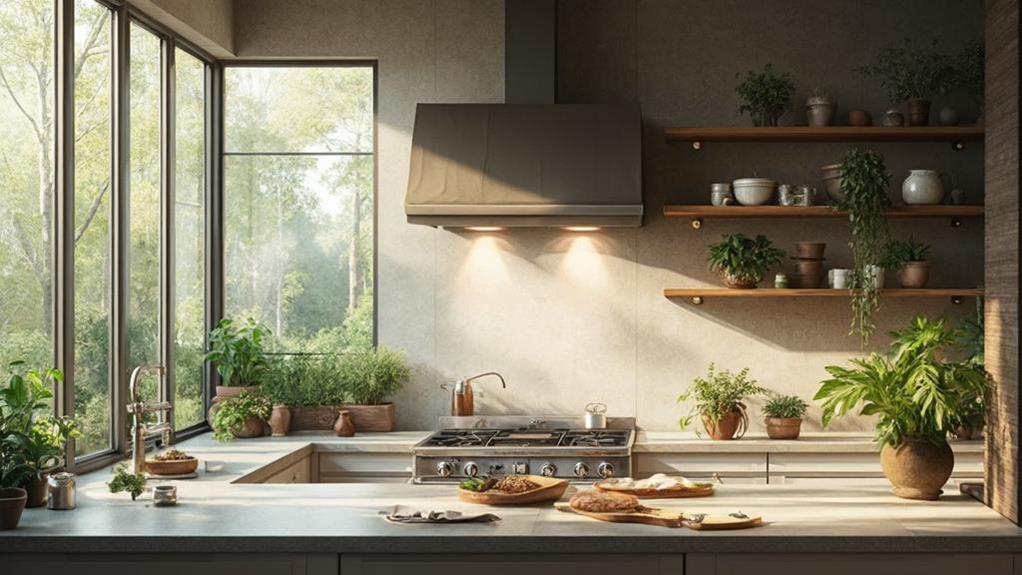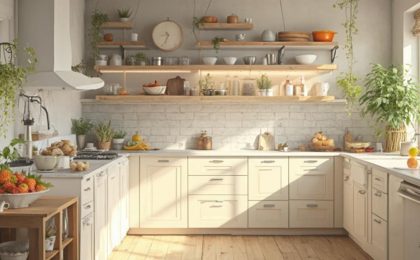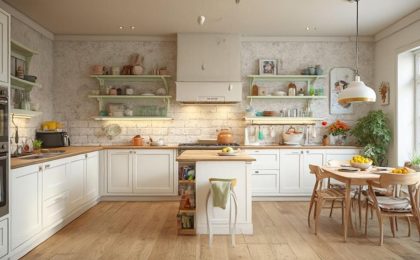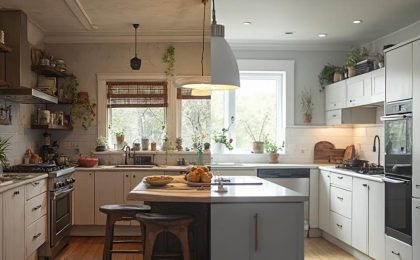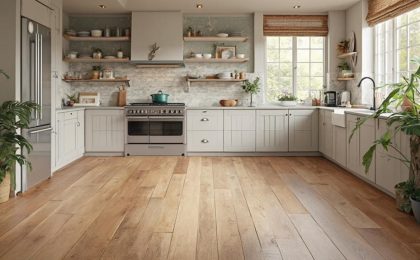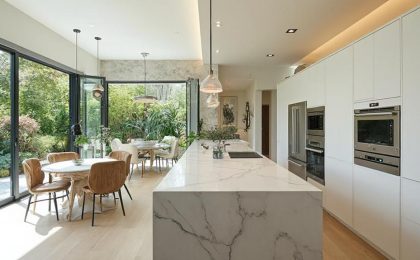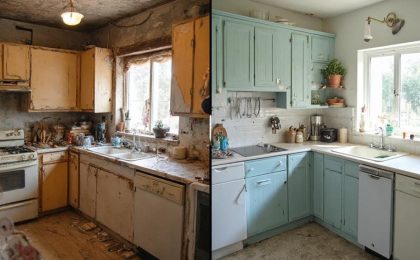When you're designing your kitchen, you might overlook ventilation, but it's essential for a functional space. Proper airflow not only keeps the air fresh but also protects your health and appliances from the adverse effects of smoke and humidity. You could be surprised by how much a well-ventilated kitchen enhances your cooking experience. Consider how strategic placement of exhaust systems can influence this aspect, and think about the common mistakes many make. What are the key features you should prioritize to guarantee your kitchen is both comfortable and efficient?
Key insights
- Proper ventilation improves air quality by expelling cooking odors, smoke, and excess heat, enhancing the overall cooking experience.
- Effective ventilation reduces airborne contaminants, promoting respiratory health and minimizing allergens like dust and mold.
- Adequate airflow prevents moisture buildup, protecting surfaces from mold growth and maintaining indoor air quality.
- Proper ventilation extends appliance lifespan by managing heat dissipation and preventing wear from humidity.
- Regular maintenance of ventilation systems ensures optimal performance and hygiene, safeguarding investments in kitchen appliances.
The Role of Ventilation
Ventilation plays an essential role in kitchen design, impacting both air quality and overall functionality. When you consider ventilation design, you're not just thinking about aesthetics; you're addressing the critical need for effective airflow dynamics. Proper ventilation guarantees that cooking odors, smoke, and excess heat are efficiently expelled, creating a comfortable environment for you and your guests.
Additionally, working with local kitchen fitters can provide valuable insights into enhancing your kitchen's airflow while guaranteeing compliance with local building regulations.
To achieve ideal airflow dynamics, you need to strategically position your range hood and exhaust systems. The placement should allow for unobstructed airflow, facilitating effective removal of airborne contaminants. You might also explore options like under-cabinet hoods or downdraft systems, which can complement your kitchen's style while maintaining efficiency.
Don't overlook the importance of intake vents, too. These elements work in tandem with exhaust systems to maintain a balanced airflow, preventing pressure imbalances that can lead to inefficiency.
Health Benefits of Proper Ventilation
A well-ventilated kitchen greatly contributes to your health and well-being. Proper ventilation removes airborne contaminants and reduces the risk of chemical exposure from cooking fumes and cleaning products. By maintaining ideal air quality, you enhance your respiratory health and promote family wellness.
Additionally, investing in comprehensive bathroom fitting services can further improve the overall health of your home environment.
Consider these key benefits:
- Allergen Reduction: Effective ventilation helps to minimize allergens like dust and mold, creating a safer environment for allergy sufferers.
- Cooking Safety: Adequate airflow prevents dangerous fumes from building up, which can lead to health issues or even accidents.
- Comfort Levels: A properly ventilated kitchen maintains comfortable temperatures, making cooking a more enjoyable experience.
Investing in energy-efficient ventilation systems not only keeps your kitchen safe but also enhances comfort levels during meal prep.
By prioritizing proper ventilation, you can foster a healthier home environment, ensuring that your family's well-being remains at the forefront.
Ultimately, a well-designed ventilation system acts as a shield against harmful pollutants while promoting a safer, more pleasant cooking space.
Impact on Cooking Odors
Proper ventilation not only enhances your health but also plays a critical role in managing cooking odors. When you're whipping up a delicious meal, the last thing you want is for lingering scents to invade your home. Effective ventilation systems actively promote odor absorption, allowing you to enjoy your culinary creations without the aftermath of overwhelming smells.
Utilizing the services of local experts, like Kitchen Fitters Bradford, can guarantee that your ventilation is optimized for your kitchen's layout and design needs.
By strategically placing range hoods or exhaust fans, you can greatly improve scent management in your kitchen. These systems capture and expel cooking fumes, grease, and odors, preventing them from settling on your walls and furnishings. Choosing a range hood with sufficient power for your cooking space is essential; the right airflow guarantees that odors are effectively removed in real-time.
Additionally, consider using activated charcoal filters, which are excellent at trapping and neutralizing odors, further enhancing your kitchen environment.
Proper ventilation not only keeps your space smelling fresh but also contributes to a more enjoyable cooking experience. So, invest in a well-designed ventilation system to guarantee your kitchen remains a pleasant space, free from the clutches of unwanted cooking odors.
Reducing Moisture and Humidity
To create a healthy kitchen environment, you need to focus on reducing moisture and humidity.
By enhancing airflow efficiency, you can prevent mold growth and greatly improve indoor air quality.
Implementing effective ventilation solutions won't only protect your surfaces but also guarantee a fresher cooking space.
Preventing Mold Growth
Maintaining ideal humidity levels is vital for preventing mold growth in kitchen environments. Excess moisture can create a breeding ground for mold, leading to health issues and structural damage.
To achieve effective mold prevention, you need to focus on humidity control throughout your kitchen.
Here are some practical tips to keep mold at bay:
- Use exhaust fans: Always turn on your exhaust fan while cooking to pull moisture outside.
- Fix leaks promptly: Regularly inspect pipes and appliances for leaks, and repair them immediately to avoid water accumulation.
- Vent appliances: Make sure your dishwasher and washing machine are properly vented to prevent trapped moisture.
By implementing these strategies, you can markedly reduce humidity and create a less favorable environment for mold.
Consider investing in a hygrometer to monitor your kitchen's humidity levels regularly. Aim to keep humidity below 60%, as this threshold is essential for effective mold prevention.
With proper ventilation and moisture management, you not only enhance your kitchen's livability but also protect your health and home from the dangers of mold growth.
Enhancing Airflow Efficiency
Effective airflow is essential for reducing moisture and humidity in your kitchen. When designing your kitchen, consider the airflow design and ventilation placement to guarantee peak efficiency. Properly placed vents and exhaust systems can greatly decrease humidity levels, making your cooking space more comfortable and functional.
To illustrate the impact of efficient airflow on moisture management, here's a simple comparison of ventilation methods:
| Ventilation Method | Airflow Efficiency | Moisture Reduction Rate |
|---|---|---|
| Range Hood | High | 90% |
| Wall Vent | Moderate | 70% |
| Open Windows | Low | 30% |
| Ceiling Fan | Moderate | 50% |
| Dehumidifier | High | 80% |
Improving Indoor Air Quality
Proper ventilation not only enhances airflow but also plays an essential role in improving indoor air quality by reducing moisture and humidity levels.
High humidity can lead to mold growth and musty odors, greatly impacting your kitchen's environment. By optimizing your ventilation, you're actively engaging in air filtration processes that remove excess moisture and promote pollutant reduction.
Consider these key benefits of proper kitchen ventilation:
- Mold Prevention: Keeping humidity levels in check helps prevent mold and mildew, making your kitchen healthier.
- Odor Control: Effective ventilation eliminates lingering cooking smells, ensuring your kitchen feels fresh.
- Improved Comfort: A well-ventilated kitchen maintains a comfortable temperature, allowing you to enjoy cooking without feeling stifled.
Protecting Kitchen Appliances
When designing your kitchen, managing heat dissipation is essential for protecting your appliances.
By ensuring proper ventilation, you not only enhance performance but also extend the longevity of your devices.
Implementing effective strategies can safeguard your investments from unnecessary wear and tear caused by excessive heat and humidity.
Heat Dissipation Strategies
In modern kitchen design, heat dissipation strategies are essential for protecting your appliances and ensuring their longevity. Proper management of heat not only enhances performance but also minimizes wear and tear on your equipment.
Start by prioritizing exhaust fan placement; positioning your fan close to heat sources like stovetops helps efficiently remove excess heat and smoke.
Additionally, consider incorporating natural ventilation techniques. Open windows or strategically placed vents can aid in circulating cool air while expelling hot air. This creates a more comfortable cooking environment and reduces the strain on energy-consuming appliances.
Here are some practical steps you can take:
- Install a range hood above your cooktop to capture heat and odors effectively.
- Choose appliances with built-in cooling systems, which help dissipate heat during operation.
- Utilize reflective materials in your kitchen design; these can help minimize heat absorption and keep your space cooler.
Appliance Longevity Maintenance
To maintain the longevity of your kitchen appliances, a proactive approach to regular maintenance can make a significant difference. Start with appliance care by routinely cleaning and checking each unit. Dust and grease buildup can lead to overheating and inefficiency, so wipe down surfaces and clean filters as needed.
Consider ventilation upgrades, too. Proper airflow is essential for preventing moisture and heat accumulation, which can adversely affect appliance performance. Verify that your kitchen's ventilation system operates effectively, directing hot air and steam away from your appliances.
Don't forget to inspect seals and gaskets on refrigerators and ovens. Worn-out seals can cause energy loss and increased strain on your appliances. Replace any damaged components promptly to maintain efficiency.
Additionally, schedule professional maintenance checks for larger appliances. Technicians can identify potential issues before they escalate, saving you from costly repairs down the line.
Lastly, always follow the manufacturer's guidelines for usage and care. This verifies you're not only extending the life of your appliances but also maximizing their performance.
Types of Ventilation Systems
Proper ventilation is essential for maintaining a healthy kitchen environment, and understanding the different types of ventilation systems available can help you make the best choice for your space.
You'll find that each system comes with its own benefits and suitability depending on your kitchen layout and cooking habits.
Here's a quick overview:
- Exhaust Fans: These are typically installed in windows or walls, effectively expelling smoke and odors outside.
- Range Hoods: Mounted above your stove, range hoods can either be ducted or ductless, and they come with various filter types to capture grease and particles.
- Ceiling Vents: These are part of a duct system that circulates air, providing a more integrated solution for active ventilation.
You can also consider passive ventilation strategies, like strategically placed windows to allow fresh air flow.
Active ventilation systems, on the other hand, rely on mechanical devices to maintain air quality.
Key Features to Consider
When choosing a ventilation system for your kitchen, several key features can greatly impact performance and user experience.
First, consider the power of the ventilation system. A model with adequate airflow (measured in CFM) guarantees that smoke, steam, and odors are effectively removed, especially in open kitchen layouts where cooking activities are central.
Next, take into account noise levels. Modern systems often come with noise-reduction technology, allowing you to enjoy a peaceful cooking environment without the distraction of a loud fan.
Another critical aspect is the system's design—ventilation aesthetics. Your choice should complement your kitchen's overall style, whether it's sleek and modern or classic and traditional. Choose a hood or vent that harmonizes with your cabinetry and appliances, creating a cohesive look.
Lastly, don't overlook the ease of maintenance. Opt for systems with easy-to-clean filters and surfaces, guaranteeing long-term efficiency and hygiene.
Common Ventilation Mistakes
Many homeowners underestimate the importance of proper ventilation and make significant mistakes that can compromise their kitchen's functionality.
It's vital to recognize these common pitfalls to guarantee a well-ventilated space that enhances your cooking experience.
Here are some common ventilation mistakes to avoid:
- Ignoring Range Hood Specifications: Many think that any range hood will work, but selecting one that matches your cooktop's size and output is fundamental.
- Underestimating Airflow Needs: Some believe that just having a fan is enough. Failing to calculate the necessary airflow can lead to poor air quality and lingering odors.
- Neglecting Duct Placement: It's a myth that ductwork placement doesn't matter. Improperly placed ducts can obstruct airflow, rendering your system ineffective.
When considering your kitchen design, keep these ventilation myths in mind.
Proper design considerations should focus on airflow, placement, and capacity to create a functional kitchen environment.
Maintenance Tips for Ventilation
Ventilation systems require regular upkeep to function efficiently and guarantee a healthy kitchen environment. To keep your kitchen air quality ideal, you need to prioritize ventilation maintenance. Here are some essential tips to make sure your system stays in top shape:
| Task | Frequency | Notes |
|---|---|---|
| Inspect ducts | Every 6 months | Look for clogs or leaks. |
| Clean exhaust fans | Monthly | Remove grease buildup. |
| Check for obstructions | Monthly | Confirm airflow is unobstructed. |
| Replace filters | Every 3 months | Choose high-efficiency filters. |
| Schedule professional maintenance | Annually | Have an expert assess your system. |
Regular filter replacement is vital; dirty filters restrict airflow and decrease efficiency. Always choose the right type of filter for your specific ventilation system. Additionally, cleaning fans and ducts can prevent grease accumulation, which could pose a fire hazard. Implementing these maintenance tips not only extends the lifespan of your system but also enhances air quality, making your kitchen a safer, more enjoyable space to cook. Keep your ventilation in check, and breathe easy!
Frequently Asked Questions
How Does Ventilation Affect Energy Efficiency in the Kitchen?
Ventilation plays a vital role in your kitchen's energy efficiency.
When you optimize airflow dynamics, you effectively remove cooking emissions, which can otherwise accumulate and force your appliances to work harder.
This means your range hood and other systems don't have to use excess energy to maintain air quality.
Can I Install a Ventilation System Myself?
Yes, you can install a ventilation system yourself if you're comfortable with DIY installation and have basic tools.
First, choose the right ventilation types—like range hoods or exhaust fans—based on your kitchen layout. Measure your space carefully and follow the manufacturer's instructions for proper installation.
Make sure you have adequate ductwork if needed, and always prioritize safety by turning off power during installation.
With patience and attention to detail, you'll create an effective ventilation system.
What Are the Costs Associated With Kitchen Ventilation Systems?
When considering kitchen ventilation systems, you'll encounter various ventilation types like range hoods, downdraft systems, and exhaust fans.
The installation costs can vary considerably based on the type you choose, with basic models starting around $100 and professional installations potentially exceeding $1,000.
Additionally, if you opt for advanced features or custom solutions, expect to budget even more.
It's crucial to evaluate your kitchen's size and layout to determine the best fit.
Are There Noise Concerns With Different Ventilation Systems?
When you consider different ventilation systems, noise levels can definitely be a concern.
Some fan types, like centrifugal fans, tend to operate more quietly, while others, like axial fans, can produce more noise.
If you're sensitive to sound, it's important to research the specific decibel ratings of each option.
You might also want to explore models with noise-reduction features to guarantee a peaceful cooking environment while maintaining ideal air circulation.
How Can I Tell if My Kitchen Needs Better Ventilation?
You can tell your kitchen needs better ventilation if you notice persistent odors, excessive humidity, or condensation on windows.
If the air quality feels stale or heavy, it's a sign you might lack adequate airflow.
Pay attention to how quickly cooking smells dissipate; if they linger, it's time to evaluate improvements for odor control.
Regularly checking for these signs can help maintain a healthier, more comfortable cooking environment for you and your family.
Summary
Incorporating proper ventilation into your kitchen design isn't just a stylistic choice; it's essential for health, comfort, and appliance longevity. By choosing the right ventilation system and understanding its key features, you can greatly enhance your cooking experience. Avoid common mistakes and prioritize regular maintenance to guarantee peak performance. Ultimately, a well-ventilated kitchen creates a healthier environment, allowing you to enjoy every culinary adventure without the worry of lingering odors or excess moisture.
